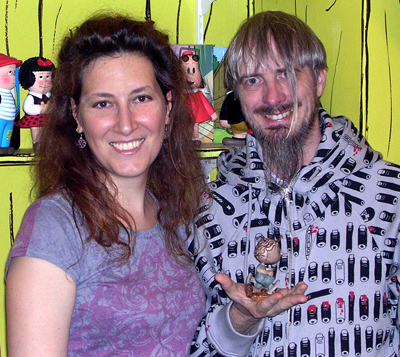As long-time collectors and Dark Horse Deluxe fans are aware, we have for the last several years been producing a remarkable line of statuettes in the style of vintage "syrocos," which are the common name for a type of figurine popular in the 1930s and 1940s.
The brainchild of Dark Horse President Mike Richardson, these limited-edition figurines are produced in very short runs, and are unique in the marketplace. Packaged in distinctive litho-printed tin boxes, the series has captured everything from the greatest newspaper comic strip characters to Kellogg's cereal mascots to comic book heroes.
Perhaps one of the most noteworthy series is the current one: a set of ten statuettes inspired by one of the greatest comics of all time, Charles Schulz's Peanuts. Produced under license from United Media, with the direct participation of the Schulz Estate, these new releases are being delivered to discriminating collectors and retailers.
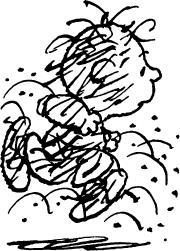 Constructing these deceptively simple sculptures is actually quite challenging, since sometimes capturing a character's essence in a simple way is often a most difficult assignment. As an example, let's look at Pig Pen.
Constructing these deceptively simple sculptures is actually quite challenging, since sometimes capturing a character's essence in a simple way is often a most difficult assignment. As an example, let's look at Pig Pen.In the Peanuts strips, this unwashed kid is largely defined by the cloud of dirt and gritty speckled dots that swirl about him. This is apparent in what we call the "source art," which is taken from the Peanuts style guide. Turning to the talents at Yoe! Studio, we found ourselves going straight to the top-President and Peanuts expert Clizia Gussoni, who graciously decided to personally supervise the translation from pen and ink to three dimensions.
"Growing up in Rome, Peanuts was one of my favorite comic strips. It appeared in newspapers, which my father used to read to me, and themed collected book editions. I always related to Peppermint Pattie, because she fell asleep in class and wasn't ready with her homework assignments--just like me!
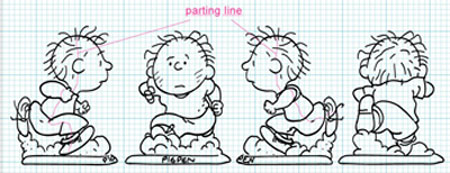
"In designing the statues, we had to think of which illustrations to pick. Like different photos of the same person, they change subtly from strip to strip. Trying to pinpoint which phase of Schulz's career to pick to depict the characters was key, since the character's appearance evolved over time. In the end, we picked the look of the characters from more-or-less the 1970s versions. "
Having provided this assessment, she had the Yoe! illustration team create the "Concept Art," which was submitted to Schulz creative team leader Paige Braddock for approval prior to sculpting. Agreeing that this direction was the way to go, we then proceeded to sculpting. This resulted in the "Clay Sculpt." The clay is a preliminary hand-crafted version of the final piece prior to casting and painting.
In Pig Pen's case, the visual solution of his hair, the dust cloud at his feet, and other details were refined. Dark Horse project manager Sarah Sturgill discussed the sculpture with Ms. Braddock, and they agreed that the approach was a good way to solve the visual problem as far as the sculpture was concerned, and outlined additional features to be addressed in the paint application phase.
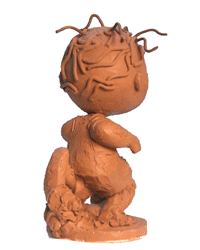
At that point, a mold was made of the clay piece, and a resin casting was created. After approval there were to be no further sculptural changes.
The Yoe! team then created a color palette, submitting the colors as designated by the widely used "PMS" color codes. Again, this was consistent with the Peanuts style guide. The coloring was essential to the success of Pig Pen. Experimentation revealed that the black speckled dots Schulz used to convey dirt and grit came off as if they were acne or skin blemishes. Ms. Gussoni came up with a smudgy paint effect that looked, well, "dirty." While this solution was actually quite different than the cartoon sketches, it was an inspired choice that really solved the problem. We had arrived at a Pig Pen that was true to the underlying character, but attainable in production.
"We started with a darker-than-usual skin color. We put a wash on top of the first paint application to give it a smudged look, trying different levels to get the right patina. It's interesting-usually with the 'syroco'-style pieces we take a complex color scheme and simplify it. With Pig Pen, we used a fairly sophisticated paint application to create an effect that appears simple. It is only a rumor that we used Craig Yoe as a model by smearing dirt and mud on his face over and over until we found what we were looking for!"
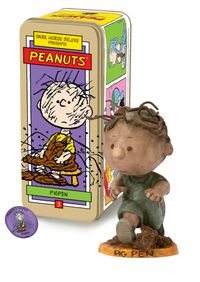 The painted version and an unpainted "tooling pattern" were then sent to the manufacturer. They reviewed it, and suggested that since his individual hairs would be overly fragile in the poly-resin material the rest of the statue was made of, that they would use thick wire for the hairs, which would be bent into shape and painted.
The painted version and an unpainted "tooling pattern" were then sent to the manufacturer. They reviewed it, and suggested that since his individual hairs would be overly fragile in the poly-resin material the rest of the statue was made of, that they would use thick wire for the hairs, which would be bent into shape and painted.Meanwhile, Sturgill coordinated the graphic design of the tin box art, as well as the booklet on the character and pinback button that are inserted into the inside lid of the box. All these were approved, and the components were sent to different manufacturers for production and subsequent delivery to the statue factory.
As the statues were produced, we receive additional samples from the production run, which were sent to United Media and the Schulz team to confirm that the quality is consistent throughout the run. Each is hand-numbered on the underside of the base. Then the finished, assembled statuettes are carefully packed for shipping into cartons of eight, with each carton numbered so the individual numbers of the contents can be determined.
These are shipped from the factory in China to Hong Kong, where they are sent via ocean freight to the Port of Seattle, and by truck to the Dark Horse warehouse for distribution.
The result is a charming collectible whose simplicity belies the complexity of its creation.
Clizia Gussoni (left) and Craig Yoe holding a Pig Pen holding a Pig Pen Syroco.
